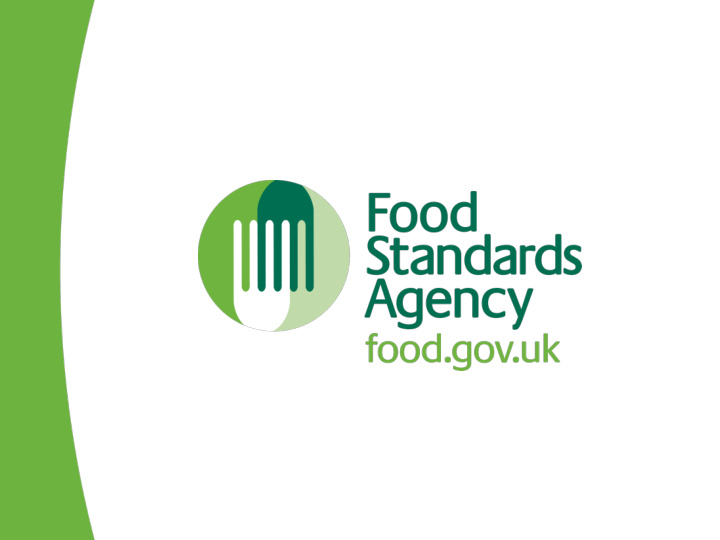



NACC Midlands Regional Meeting 17 February 2015 Tracey Smith Foodborne Disease Control FSA Foodborne Disease Strategy • Campylobacter Risk Management Programme • Listeria Risk Management Programme • Other pathogens
Acting on Campylobacter Together (ACT) Campaign • Tackling Campylobacter is FSA top priority in the fight against food poisoning. • The most significant source of Campylobacter with respect to human health is raw poultry meat - 70% campylobacteriosis cases can be attributed to chicken. • ACT campaign brings together work from farm to fork, including chicken producers, processors, caterers and retailers.
On farm Slaughter, processing Retail Consumers Food business
Consumers • Don’t wash raw chicken. • Washing raw chicken can spread Campylobacter by splashing contaminated water to other surfaces.
Food business Raise awareness of Campylobacter • Include Campylobacter messaging in training materials e.g. for EHOs, food hygiene trainers, FBOs, food handlers, catering students. • Raise awareness of Campylobacte r improved risk management through better handling, cooking and good kitchen hygiene practices.
Campylobacter - What next? • ACT e-newsletter published – sign up at: http://www.food.gov.uk/news- updates/campaigns/campylobacter/actnow/act-e-newsletter • Publication of Q3 Retail Survey Results • Food Safety Week - May 2015 • Continuing to discuss initiatives and interventions with industry partners
Listeria Risk Management Programme • Promote awareness of groups that are Consumer at risk and behaviours that can help behaviour them to prevent infection Procurement/ • Reduce risk through procurement policy provision to high and consideration of supply processes to dependent and high risk groups risk groups Industry • Reduce contamination of higher risk Compliance and foods through improved guidance and enforcement work Enforcement
Listeriosis • Infection caused by Listeria monocytogenes (Listeriosis) is rare but is the number one cause of death due to foodborne disease in the UK. • Most cases are hospitalised and approximately a third die. • Generally associated with ready-to-eat foods - 73% of listeriosis outbreaks (2003-2012) were associated with hospital sandwiches.
Higher risk foods • Higher risk foods for L. monocytogenes are generally: – Ready-to-eat – Able to support the growth of the bacterium – Sold with a long shelf life – Chilled, i.e. refrigerated
High-risk population groups Listeriosis generally affects those with reduced immunity: – Pregnant women and their unborn babies – Newborns – People aged over 60 years – Patients with specific underlying medical conditions and/or undergoing certain drug treatments – Weakened immunity
What are we doing? • FSA Strategy for 2015-2020 will include listeria . • FSA commissioned research. • Draft guidance for healthcare organisations. • Listeria workshops for hospitals. • Listeria messaging for consumers/carers. • Online decision support tools for small manufacturers.
Listeria guidance for hospitals and healthcare organisations • Guidance aims to help healthcare organisations reduce the risk of vulnerable groups contracting Listeriosis and highlight important controls for L. monocytogenes. Includes guidance on: – Control of growth – Control of contamination – Management controls – Methods of supplier assessment – Advice for sampling plans
Listeria controls Effective chilling Personnal hygiene, Effective Effective cleaning particularly management and disinfection handwashing, controls and procedures and handling training practices Cross- contamination control Separation between raw and ready-to-eat foods
Further information • Listeria Risk Management Programme: http://www.food.gov.uk/science/microbiology/listeria • Campylobacter : http://www.food.gov.uk/policy- advice/microbiology/campylobacterevidenceprogramme/ • E.coli O157: Control of cross-contamination refreshed guidance: http://www.food.gov.uk/news- updates/news/2014/6106/ecoli
Any questions? tracey.smith@foodstandards.gsi.gov.uk
Recommend
More recommend